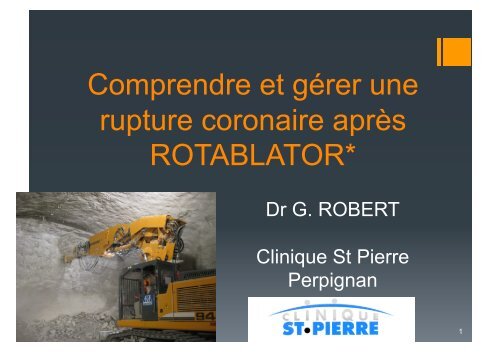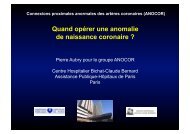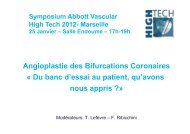Télécharger la présentation - Mediathèque du congrès de High ...
Télécharger la présentation - Mediathèque du congrès de High ...
Télécharger la présentation - Mediathèque du congrès de High ...
Create successful ePaper yourself
Turn your PDF publications into a flip-book with our unique Google optimized e-Paper software.
Comprendre et gérer une<br />
rupture coronaire après<br />
ROTABLATOR*<br />
Dr G. ROBERT<br />
Clinique St Pierre<br />
Perpignan<br />
1
Comprendre <strong>la</strong> perforation:<br />
Quel type?<br />
Pour qui?<br />
Pourquoi?<br />
Quand?<br />
Cas clinique<br />
Comment <strong>la</strong> prévenir?<br />
Gestion <strong>de</strong> <strong>la</strong> complication<br />
2
C<strong>la</strong>ssification <strong>de</strong>s perforations coronariennes<br />
ELLIS<br />
Type I : Cratère extraluminal sans extravasation<br />
Type II : Blush péricardique ou myocardique sans<br />
extravasation <strong>de</strong> jet <strong>de</strong> contraste<br />
Type III : Extravasation / jet <strong>de</strong> contraste à travers une<br />
perforation ( ≥ 1mm ) ou bien opacification d’une cavité<br />
anatomique ( ventricule , espace péricardique… )<br />
FUKUTOMI<br />
Type I : Tatouage épicardique sans extravasation <strong>de</strong> contraste<br />
Type II : Extravasation avec jet <strong>de</strong> contraste visible<br />
KINI<br />
Type I : Fukutomi type I<br />
Type II : Ellis type III<br />
3
Perforation coronaire: pour qui?<br />
4
In-Hospital Outcomes of Contemporary Percutaneous Coronary Intervention<br />
in Patients With Chronic Total Occlusion: Insights From the J-CTO Registry<br />
(Multicenter CTO Registry in Japan)<br />
Inci<strong>de</strong>nce, Predictors, Management,<br />
Yoshihiro Morino, Takeshi Kimura, Yasuhiko Hayashi, Toshiya Muramatsu,<br />
Masahiko Ochiai, Yuichi Noguchi, Kenichi Kato, Yoshisato Shibata, Yoshikazu<br />
Immediate<br />
Hiasa, Osamu Doi,<br />
and<br />
Takehiro<br />
Long-Term<br />
Yamashita, Takeshi<br />
Outcomes<br />
Morimoto, Mitsuru Abe,<br />
Following<br />
Tomoaki<br />
Hinohara, Kazuaki Mitsudo, for the J-CTO Registry Investigators<br />
Gra<strong>de</strong> III Coronary Perforation<br />
J. Am. Coll. Cardiol. Intv. 2010;3;143-151<br />
doi:10.1016/j.jcin.2009.10.029<br />
This information is current as of November 16, 2011<br />
R. Al The Lamee, online version A. of Ie<strong>la</strong>si, this article, A. along Latib, with updated C. Godino, information M. and Ferraro, services, is M.<br />
located on the World Wi<strong>de</strong> Web at:<br />
Mussardo, http://interventions.onlinejacc.org/cgi/content/full/3/2/143<br />
F. Arioli, M. Carlino, M. Montorfano, A. Chieffo<br />
and Antonio Colombo<br />
J. Am. Coll. Cardiol. Intv. 2011 ; 4 ; 87- 95<br />
5
from<br />
CE at<br />
. We<br />
ce of<br />
finite.<br />
rmed<br />
Inc.,<br />
ed as<br />
rceniables<br />
ed to<br />
onary<br />
Varicorobe<br />
of<br />
rature<br />
o<strong>de</strong>lrcumy<br />
ocomy,<br />
scu<strong>la</strong>r<br />
tuous<br />
The <strong>de</strong>vice causing perforation was an intracoronary balloon in<br />
50.0% (n 28) of patients with a compliant balloon used in<br />
53.6% (n 15) and a noncompliant balloon used in 46.4% (n <br />
13). Perforation occurred <strong>du</strong>ring pre-di<strong>la</strong>tion before stent imp<strong>la</strong>n-<br />
Caractéristiques cliniques<br />
24465 pts / 56 perforations type 3<br />
Table 1. Baseline Clinical Characteristics (n 56)<br />
Age, yrs 66.5 12.1<br />
Male sex 44 (78.6)<br />
Ejection fraction 55.8 9.1<br />
Prior myocardial infarction 25 (44.6)<br />
Prior PCI 22 (39.3)<br />
Prior CABG 6 (10.7)<br />
Unstable angina (CCS IV) 4 (7.1)<br />
Stable angina (CCS I–III) 46 (82.2)<br />
Silent ischemia (CCS 0) 6 (10.9)<br />
Multivessel disease 42 (76.4)<br />
Renal impairment (p<strong>la</strong>sma creatinine 1.4 mg/dl) 4 (7.1)<br />
Cardiovascu<strong>la</strong>r risk factors<br />
Family history of coronary artery disease 22 (39.3)<br />
Hypertension 35 (62.5)<br />
Hypercholesterolemia 38 (67.9)<br />
Current smoker 5 (8.9)<br />
Diabetes mellitus 8 (14.3)<br />
Al-Lamee et<br />
Data<br />
al. J.Am.Coll.Cardiol.Interv.<br />
presented as percentages<br />
2011<br />
and absolute numbers or mean SD.<br />
v<br />
v<br />
v<br />
( % )<br />
CABG coronary artery bypass graft; CCS Canadian Cardiovascu<strong>la</strong>r Society; PCI percuta-<br />
6
90<br />
Al-Lamee et al.<br />
Gra<strong>de</strong> III Coronary Perforation During PCI<br />
JACC:<br />
Caractéristiques <strong>de</strong>s lésions traitées<br />
Table 2. Lesion Characteristics (n 56)<br />
Vessel<br />
Left anterior <strong>de</strong>scending 25 (44.6)<br />
Circumflex 7 (12.5)<br />
Right coronary artery 13 (23.2)<br />
Intermediate 1 (1.8)<br />
First diagonal 3 (5.4)<br />
Second diagonal 1 (1.8)<br />
Obtuse marginal 3 (5.4)<br />
Septal 1 (1.8)<br />
Saphenous vein graft 2 (3.6)<br />
Lesion location<br />
Ostial 4 (7.1)<br />
Proximal 22 (39.2)<br />
Mid 26 (46.4)<br />
Distal 4 (7.1)<br />
Lesion and vessel morphology<br />
Type A 0<br />
Type B1 2 (3.6)<br />
Type B2 24 (44.6)<br />
Type C 29 (51.8)<br />
Chronic total occlusion 16 (28.6)<br />
Significant calcification 13 (23.2)<br />
Small vessel 2.5 mm 18 (32.1)<br />
Al-Lamee et al. J.Am.Coll.Cardiol.Interv. 2011<br />
Data presented as percentages and absolute numbers or mean SD.<br />
v<br />
v<br />
v<br />
grafts (InSitu<br />
sota) with 3-,<br />
and 19-mm le<br />
performed in<br />
successful in<br />
patients (n <br />
formed in 1<br />
perforation. A<br />
16.0% (n <br />
rupture in 44.<br />
were required<br />
39.3% (n 2<br />
resuscitation<br />
overall intrapr<br />
The character<br />
treatment are<br />
Predictors of g<br />
logistic regress<br />
coronary perfo<br />
mo<strong>de</strong>l was 0.7<br />
Hosmer-Leme<br />
confirming go<br />
mo<strong>de</strong>l that est<br />
predictors of p<br />
7<br />
In-hospital ou<br />
patient had an
122.8). Most patients (n 44, 95.7%) were asymptomatic at<br />
follow-up with symptoms of stable angina in the remain<strong>de</strong>r<br />
(n 2, 4.3%). The in-stent restenosis rate was 38.5% (n 10)<br />
Causes et actions principales<br />
Table 4. Characteristics of Gra<strong>de</strong> III Coronary Perforation (n 56)<br />
Device causing rupture<br />
Compliant balloon 15 (26.8)<br />
Mean balloon artery ratio 1.3 0.2<br />
Noncompliant balloon 13 (23.2)<br />
Mean balloon artery ratio 1.3 0.3<br />
Stent <strong>de</strong>livery system 10 (17.8)<br />
Cutting balloon 4 (7.1)<br />
Directional atherectomy 2 (3.6)<br />
Rotab<strong>la</strong>tion 2 (3.6)<br />
Hydrophilic wire 2 (3.6)<br />
Nonhydrophilic wire 8 (14.3)<br />
Action following rupture<br />
Pericardiocentesis 16 (28.6)<br />
Emergency intra-aortic balloon pump 11 (19.6)<br />
Heparin reversal 24 (42.9)<br />
Al-Lamee et al. J.Am.Coll.Cardiol.Interv. 2011<br />
Data presented as percentages and absolute numbers or mean SD.<br />
v<br />
v<br />
( % )<br />
to have<br />
One pa<br />
therapy<br />
imp<strong>la</strong>nt<br />
with dru<br />
with <strong>la</strong>t<br />
in<strong>de</strong>x pr<br />
treated w<br />
recovery<br />
PTFE s<br />
and was<br />
Table 5.<br />
Coronar<br />
Type B2/<br />
Coronary<br />
Rotab<strong>la</strong>ti<br />
Intravasc<br />
8<br />
CI confi
Facteurs prédictifs <strong>de</strong> perforations<br />
OR 95% CI for OR p Value<br />
Type B2 / C lesions 3.75 1,47 – 9,60 0,006<br />
Coronary occlusion 1.91 1,02 – 3,60 0,045<br />
Rotab<strong>la</strong>tor 3,47 1,57 – 7,58 0,002<br />
IVUS gui<strong>de</strong>d proce<strong>du</strong>re 5,36 3,10 – 9,25 < 0,001<br />
Al-Lamee et al. J.Am.Coll.Cardiol.Interv. 2011 9
Successful 1 (100)<br />
CABG and surgical repair of perforation 9 (16.0)<br />
Résultats immédiats<br />
Successful 4 (44.4)<br />
Multiple treatment methods used 22 (39.3)<br />
Overall successful treatment of rupture 50 (87.7)<br />
Proce<strong>du</strong>ral complications n 56<br />
Cardiopulmonary resuscitation 11 (19.6)<br />
Death 2 (3.6)<br />
In-hospital complications n 54<br />
Acute stent thrombosis 1 (1.9)<br />
Necessity for CABG 2 (3.7)<br />
Death 8 (14.8)<br />
Combined proce<strong>du</strong>ral and in-hospital events n 56<br />
Myocardial infarction 24 (42.9)<br />
Major adverse cardiac event 31 (55.4)<br />
Data presented as percentages and absolute numbers or mean SD.<br />
Al-Lamee et al. J.Am.Coll.Cardiol.Interv. 2011<br />
GPI glycoprotein IIb/IIIa inhibitors; other abbreviations as in Table 1.<br />
10
JACC: CARDIOVASCULAR INTERVENTIONS, VOL. 4, NO. 1, 2011<br />
JANUARY 2011:87–95<br />
Résultats à long terme<br />
Table 7. Long-Term Outcome During the Follow-Up Period<br />
( % )<br />
Follow-up n = 46<br />
Months 38.1 (7.6–122.8)<br />
Months of <strong>du</strong>al antip<strong>la</strong>telet therapy 1.0 (0–6.0)<br />
Angiographic follow-up obtained 26 (56.5)<br />
Angina CCS c<strong>la</strong>ss<br />
Unstable angina (CCS IV) 0<br />
Stable angina (CCS I–III) 2 (4.3)<br />
Asymptomatic (CCS 0) 44 (95.7)<br />
Restenosis 10 (38.4)<br />
Death following discharge 7 (15.2)<br />
Cardiac <strong>de</strong>ath 3 (6.5)<br />
Myocardial infarction 2 (4.3)<br />
Need for CABG 2 (4.3)<br />
Target lesion revascu<strong>la</strong>rization 6 (13.0)<br />
Target vessel revascu<strong>la</strong>rization 9 (19.6)<br />
Stent thrombosis 4 (8.6)<br />
Major adverse cardiac event 19 (41.3)<br />
Al-Lamee et Data al. J.Am.Coll.Cardiol.Interv. presented as percentages 2011 and absolute numbers, mean SD, or median (interquartile<br />
range).<br />
11<br />
Pre<br />
bined<br />
sugges<br />
PCI to<br />
with a<br />
also b<br />
preval<br />
ever, s<br />
tion i<br />
inci<strong>de</strong><br />
interve<br />
to the<br />
anatom<br />
This m<br />
istics<br />
pared<br />
the us<br />
corona<br />
betwee
Perforation coronaire: pour quoi?<br />
le ou les coupables(s) potentiel(s)<br />
Le gui<strong>de</strong> 0,09<br />
La fraise<br />
Le ballon après « fraisage »<br />
La son<strong>de</strong> <strong>de</strong> stimu<strong>la</strong>tion<br />
… l’opérateur?<br />
12
Perforation coronaire: quand?<br />
Procé<strong>du</strong>re à chaud ou à froid<br />
Procé<strong>du</strong>re à chaud:<br />
Pb <strong>de</strong> <strong>la</strong> lésion résistante ou non<br />
franchissable / angu<strong>la</strong>tion / petit vaisseau<br />
Fraise <strong>de</strong> petit calibre en 1 ière intention<br />
Procé<strong>du</strong>re à froid:<br />
Pb d’indication >>> pb technique<br />
13
Perforation coronaire: quand?<br />
Immédiate ou retardée<br />
Immédiate<br />
Retardée car non vue d’emblée:<br />
Echo si instabilité clinique et/ou hémo<br />
Contrôle CORO<br />
Surveil<strong>la</strong>nce USIC<br />
14
Comprendre <strong>la</strong> perforation:<br />
Pour qui?<br />
Pourquoi?<br />
Où?<br />
Quand?<br />
Cas clinique<br />
Comment <strong>la</strong> prévenir?<br />
Gestion <strong>de</strong> <strong>la</strong> complication<br />
15
CAS CLINIQUE <br />
« Mieux vaut un raccommodage qu’un trou » <br />
proverbe éthiopien <br />
JC MACIA <br />
Département <strong>de</strong> Cardiologie <br />
MONTPELLIER
Madame HC, 81 ans <br />
HTA, Hypercholestérolémie, IMC 30, AOMI <br />
SCA ST-‐, troponine + <br />
ECG: T-‐ inférieur, ECHO: VG normal <br />
Porteuse JR4 6F, gui<strong>de</strong> Whisper, ballons MAVERICK 2 2.5*12, 2.5*9, 3*9 mm
Madame HC, 81 ans <br />
HTA, Hypercholestérolémie, IMC 30, AOMI <br />
SCA ST-‐, troponine + <br />
ECG: T-‐ inférieur, ECHO: VG normal <br />
Porteuse JR4 6F, gui<strong>de</strong> Whisper, ballons MAVERICK 2 2.5*12, 2.5*9, 3*9 mm
Madame HC, 81 ans <br />
HTA, Hypercholestérolémie, IMC 30, AOMI <br />
SCA ST-‐, troponine + <br />
ECG: T-‐ inférieur, ECHO: VG normal <br />
Porteuse AL1 6F, gui<strong>de</strong> BHW, ballons C et NC <strong>de</strong> 3mm <br />
Echec <strong>de</strong> pose <strong>de</strong> stent MICRODRIVER 2.5*8 <br />
-‐>ROTABLATOR
-‐>ROTABLATOR <br />
Porteuse AL1, gui<strong>de</strong> BHW, ballon <br />
Maverick OTW 2.5*9 mm, gui<strong>de</strong> Rota <br />
wire Extra support, <br />
Rotalink 1.5 mm: <br />
-‐progression sur 4 passages dans les <br />
angu<strong>la</strong>eons, <br />
-‐difficultés sur CD2, <br />
-‐retrait pareel <strong>du</strong> gui<strong>de</strong> proche <strong>de</strong> <strong>la</strong> <br />
paree floppy, <br />
-‐fraisage en re<strong>la</strong>eve <strong>de</strong>saxaeon par <br />
rapport à <strong>la</strong> lumière, <br />
-‐retrait « acci<strong>de</strong>ntel » <strong>de</strong> <strong>la</strong> totalité <strong>du</strong> <br />
matériel en DYNAGLIDE, <br />
-‐passage d’un gui<strong>de</strong> Whisper« à <strong>la</strong> <br />
volée » après une injeceon « test »….. <br />
Madame HC, 81 ans <br />
HTA, Hypercholestérolémie, IMC 30, AOMI <br />
SCA ST-‐, troponine + <br />
ECG: T-‐ inférieur, ECHO: VG normal
Madame HC, 81 ans <br />
HTA, Hypercholestérolémie, IMC 30, AOMI <br />
SCA ST-‐, troponine + <br />
ECG: T-‐ inférieur, ECHO: VG normal <br />
2 Inf<strong>la</strong>eons prolongées avec un ballon MAVERICK 2 <strong>de</strong> 3*15 mm (15 minutes)
Madame HC, 81 ans <br />
HTA, Hypercholestérolémie, IMC 30, AOMI <br />
SCA ST-‐, troponine + <br />
ECG: T-‐ inférieur, ECHO: VG normal <br />
2 Inf<strong>la</strong>eons prolongées avec un ballon MAVERICK 2 <strong>de</strong> 3*15 mm (15 minutes)
Madame HC, 81 ans <br />
HTA, Hypercholestérolémie, IMC 30, AOMI <br />
SCA ST-‐, troponine + <br />
ECG: T-‐ inférieur, ECHO: VG normal <br />
Echec <strong>de</strong> pose d’un JOSTENT <strong>de</strong> 3*16 mm, drainage péricardique <br />
Steneng « Conveneonnel » DRIVER 3*18, 3*24, 3.5*18, 3.5*12 et 3*9 mm
Madame HC, 81 ans <br />
HTA, Hypercholestérolémie, IMC 30, AOMI <br />
SCA ST-‐, troponine + <br />
ECG: T-‐ inférieur, ECHO: VG normal <br />
Echec <strong>de</strong> pose d’un JOSTENT <strong>de</strong> 3*16 mm, drainage péricardique <br />
Steneng « Conveneonnel » DRIVER 3*18, 3*24, 3.5*18, 3.5*12 et 3*9 mm
Madame HC, 81 ans <br />
HTA, Hypercholestérolémie, IMC 30, AOMI <br />
SCA ST-‐, troponine + <br />
ECG: T-‐ inférieur, ECHO: VG normal <br />
Echec <strong>de</strong> pose d’un JOSTENT <strong>de</strong> 3*16 mm, drainage péricardique <br />
Steneng « Standard » DRIVER 3*18, 3*24, 3.5*18, 3.5*12 et 3*9 mm
Madame HC, 81 ans <br />
HTA, Hypercholestérolémie, IMC 30, AOMI <br />
SCA ST-‐, troponine + <br />
ECG: T-‐ inférieur, ECHO: VG normal <br />
Echec <strong>de</strong> pose d’un JOSTENT <strong>de</strong> 3*16 mm, drainage péricardique <br />
Steneng « Conveneonnel » DRIVER 3*18, 3*24, 3.5*18, 3.5*12 et 3*9 mm
Madame HC, 81 ans <br />
HTA, Hypercholestérolémie, IMC 30, AOMI <br />
SCA ST-‐, troponine + <br />
ECG: T-‐ inférieur, ECHO: VG normal <br />
Echec <strong>de</strong> pose d’un JOSTENT <strong>de</strong> 3*16 mm, drainage péricardique <br />
Steneng « Conveneonnel » DRIVER 3*18, 3*24, 3.5*18, 3.5*12 et 3*9 mm
Madame HC, 81 ans <br />
HTA, Hypercholestérolémie, IMC 30, AOMI <br />
SCA ST-‐, troponine + <br />
ECG: T-‐ inférieur, ECHO: VG normal <br />
RESULTAT ! <br />
EVOLUTION : Troponine 1.5, retrait <strong>du</strong> drain J1, FA paroxyseque, Soree J6 post <br />
procé<strong>du</strong>re, DCD à 84 ans d’un adénocarcinome colique
Comprendre <strong>la</strong> perforation:<br />
Pour qui?<br />
Pourquoi?<br />
Où?<br />
Quand?<br />
Cas clinique<br />
Comment <strong>la</strong> prévenir?<br />
Gestion <strong>de</strong> <strong>la</strong> complication<br />
29
Prévention<br />
Respect <strong>de</strong>s CI<br />
Evaluation <strong>du</strong> rapport B/R<br />
Expérience au service <strong>de</strong> <strong>la</strong> technique<br />
30
Prévention: Evaluation <strong>du</strong><br />
rapport B/R<br />
Pt non éligible pour une éventuelle chir<br />
Lésions complexe 3T avec mauvais VG<br />
TC complexe non protégé<br />
Lésion angulée > 45°, surtout Cx<br />
Lésion > 30 mm, surtout petit vx<br />
31
Prévention: Expérience au<br />
service <strong>de</strong> <strong>la</strong> technique<br />
Guiding coaxial 6 ou 7F<br />
Intérêt IVUS / OCT + imagerie <strong>de</strong> qualité<br />
Contrôle permanent distalité gui<strong>de</strong><br />
Ratio fraise/artère 0,5 à 0,6<br />
Résultat gui<strong>de</strong> en p<strong>la</strong>ce en > 2 inci<strong>de</strong>nces<br />
Ne pas retar<strong>de</strong>r <strong>la</strong> technique et …<br />
Savoir s’arrêter …<br />
32
Gestion <strong>de</strong> <strong>la</strong> perforation:<br />
Travail d’équipe / Centre expérimenté<br />
Cardio interventionnel:<br />
maintenir gui<strong>de</strong> + gonfler un ballon<br />
déci<strong>de</strong>r au + vite correction<br />
drainage péricar<strong>de</strong> + manœuvres d’assistance si<br />
nécessaire<br />
2 ième Cardio en salle: écho en salle + réa<br />
Anesthésiste/Réanimateur:<br />
Maintien état hémod<br />
Sédation +/- VA<br />
33
Gestion <strong>de</strong> <strong>la</strong> perforation type 3:<br />
les moyens<br />
Toujours une longue inf<strong>la</strong>tion avec ballon<br />
occlusif<br />
Stent couvert<br />
Stent conventionnel ou superposition <strong>de</strong><br />
stents<br />
Ballon <strong>de</strong> perfusion + chir en urgence<br />
dans les cas extrêmes<br />
34
worse short-term outcomes in patients with coronary<br />
perforation and that these agents should be used with<br />
caution in high-risk proce<strong>du</strong>res (5).<br />
Study limitations. There are some limitations of this study:<br />
Perforation coronarienne <strong>de</strong> type 3<br />
Stratégie thérapeutique<br />
1) it was a retrospective study; 2) the popu<strong>la</strong>tion size was<br />
An interventional cardiologist must be prepared for this<br />
iatrogenic event; all teams should be equipped with the<br />
necessary skills and technology required for treatment and<br />
should be prepared to react quickly and efficiently in the<br />
event of perforation. Despite treatment measures, this<br />
Al-Lamee et al. J.Am.Coll.Cardiol.Interv. 2011 35<br />
Figure 3. Flowchart for the Treatment of Gra<strong>de</strong> III Coronary Perforation Based on Our Experience
Symposium Boston Scientific<br />
25 janvier 2012 ; 17h – 19h Salle Endoume<br />
Le Rotab<strong>la</strong>tor : plus <strong>de</strong> vingt ans et pas une ri<strong>de</strong> !<br />
L’histoire d’un c<strong>la</strong>ssique dont on ne peut se passer.<br />
Modérateurs : P. Dupouy (Antony), V. Stratiev (St Denis), P. Meyer (St-Laurent-<strong>du</strong>-Var)<br />
Quelles indications en 2012 ? P. Meyer (St-Laurent-<strong>du</strong>-Var)<br />
Rotab<strong>la</strong>tor en bail-out sur échec d’angiop<strong>la</strong>stie P. Commeau (Ollioules)<br />
Tips & Tricks<br />
- Comment apprivoiser le gui<strong>de</strong> ? B. Huret (Caen)<br />
- Technique <strong>de</strong> fraisage P. Brunel (Nantes)<br />
- Quand s’arrêter <strong>de</strong> fraiser pour compléter au ballon? M. Gi<strong>la</strong>rd (Brest)<br />
Comprendre et gérer les complications<br />
- Rupture <strong>de</strong> coronaire G. Robert (Perpignan)<br />
- La coronaire ne circule plus T. Lhermusier (Toulouse)<br />
- La fraise bloquée ne revient pas P. Meyer (St Laurent <strong>du</strong> Var)<br />
Conclusions






